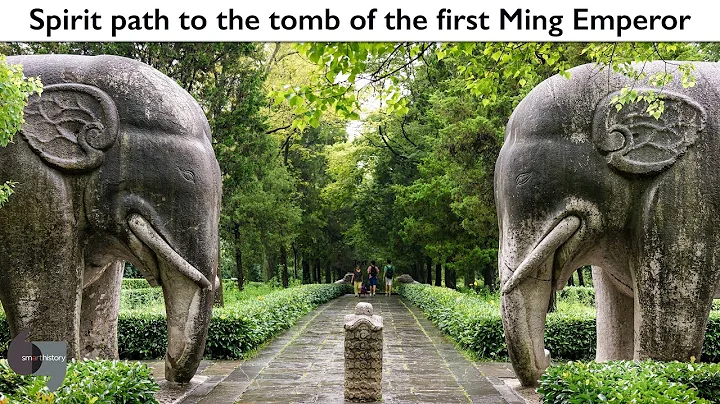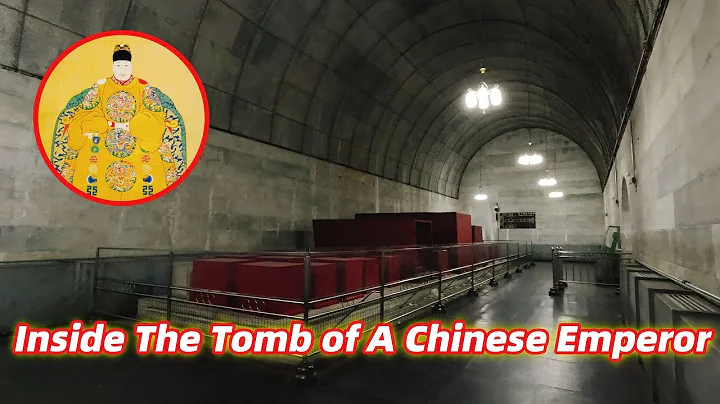In 1997, archaeologists conducted an investigation on Zhu Yuanzhang's mausoleum-Ming Xiaoling, and the results shocked everyone.
discovered through investigation that the funerary objects in the underground palace were intact.
In other words, the Xiaoling Mausoleum of the Ming Dynasty has never been visited by tomb robbers such as the "Mojin Xiaowei". This is simply incredible.
You must know that the Xiaoling Tomb of the Ming Dynasty is one of the largest imperial mausoleums in ancient my country. It covers an area of more than 1.7 million square meters. There should also be a large number of gold, silver, jade, silk and satin buried in the underground palace.

So Zhu Yuanzhang can lie quietly in the coffin of the underground palace, which is something that many archaeologists can hardly imagine.
Then why did the Xiaoling Mausoleum of the Ming Dynasty survive more than 600 years peacefully without being visited by tomb robbers such as "the captain who touched the gold" and the "general faqiuzhonglang"?
The Construction of Xiaoling Mausoleum in the Ming Dynasty
Zhu Yuanzhang was the founding emperor of the Ming Dynasty. He started as a "begging bowl" and became the ruler of the world. His life can be described as extremely legendary.
As a famous emperor in Chinese history, after Zhu Yuanzhang unified the world, he kept thinking about where to bury him after his death?

So Zhu Yuanzhang summoned his ministers and went to the suburbs to select a site, including the first counselor of the Ming Dynasty Liu Bowen .
"Liu Aiqing, I know that you even know about Feng Shui and gossip, can you choose a Feng Shui treasure land for me? Let me not be disturbed by the little ones in a hundred years."
Liu Bowen immediately knelt on the ground and said: "I can choose it for Your Majesty. The address of the mausoleum is an honor for me, and I will do my best. "
According to Zhu Yuanzhang's request, he wanted to be buried near Nanjing, so Liu Bowen began to select a location.

First, observe the shape of the mountains and rivers and look for the location of the dragon veins. Then after finding the dragon vein, Liu Bowen evaluated it and analyzed whether the Feng Shui pattern was superior enough.
Next, Liu Bowen observed the water veins around the dragon vein, observed its flow and distribution, and finally determined the location of the tomb.
When Zhu Yuanzhang received Liu Bowen's memorial, it read "Dulongfu at the southern foot of Jinshan Mountain to visit Mount Everest". In
1381 ( Hongwu fourteenth year), the construction of the imperial mausoleum officially began.
Unexpectedly, Queen Ma died of illness in the second year. This made Zhu Yuanzhang very sad, so he buried Queen Ma in the imperial mausoleum.

At the same time, this mausoleum was also named Xiaoling because of Queen Ma's posthumous title "Xiaoci".
It was not until 1398 that the 71-year-old Zhu Yuanzhang ended his magnificent life and was sent to Xiaoling by Jianwen Emperor Zhu Yunwen to be buried with Queen Ma.
However, the Ming Xiaoling Tomb was not completely completed at that time. Later, Emperor Jianwen Zhu Yunwen and Ming Chengzu Zhu Di continued to build it. It was not completed until 1413 (the eleventh year of Yongle ).
Although there are historical data to prove the construction of Xiaoling Mausoleum in the Ming Dynasty, there is also a popular saying among the people that Zhu Yuanzhang did not choose the only address for his mausoleum.

There are also similarities between Zhu Yuanzhang's funeral ceremony and Cao Cao's " Seventy-Two Suspicious Tombs".
After Zhu Yuanzhang died, Emperor Jianwen Zhu Yunwen ordered all the city gates inside and outside Nanjing to be opened, and the coffins were taken out at the same time. There were a total of 13 coffins, facing different directions, and Zhu Yuanzhang was finally buried.
So no one knows the exact location of Zhu Yuanzhang’s tomb.
Although there is this legend among the people, in the years that followed, it was generally believed that Zhu Yuanzhang was buried in the Ming Xiaoling Mausoleum at the southern foot of Purple Mountain.

Emperors of the Ming Dynasty all sent heavy troops to protect it. Even in the Qing Dynasty, they also sent people to protect and repair it. Kangxi would also come here to worship.
The reason why Ming Xiaoling Tomb was not stolen
In 1997, archaeologists began to explore the Ming Xiaoling Tomb.
After investigation, it was found that the Xiaoling Tomb of the Ming Dynasty had a round dome, and the underground palace was just below the dome, covering an area of more than 4,000 square meters.
To the regret of archaeologists, the Xiaoling Tomb of the Ming Dynasty is no longer what it looked like when it was first built.
This is because the Taiping Rebellion during the Qing Dynasty period damaged many buildings on the surface of the Ming Xiaoling Tomb. Later Emperor Tongzhi only made some relatively minor repairs and did not restore it to its original appearance.

During the late Qing Dynasty and the Republic of China, a large number of foreign tourists and explorers came to Ming Xiaoling Mausoleum and graffitied. The remaining traces cannot be eliminated until now.
During the war, due to the need to build fortifications, many trenches were dug in the Ming Xiaoling Mausoleum, and many of the walls on the surface were directly destroyed.
This caused a devastating blow to the Xiaoling Mausoleum of the Ming Dynasty, and many buildings no longer looked like their original appearance.
Even so, the Xiaoling Tomb of the Ming Dynasty still escaped the private tomb robbers who "touched the gold school captain", and also deterred the Dongling thief Sun Dianying . Why is this?

After expert discussion, there are three major reasons why Ming Xiaoling Tomb has not been stolen so far.
The first is the geographical location factor.
Under Liu Bowen's suggestion, the Ming Xiaoling Mausoleum was located in Dulongfu, Nanjing, at the southern foot of Purple Mountain to visit Mount Everest.
You must know that Dulongfu is a stone mountain with a very solid mountain structure. During the construction, craftsmen hollowed out the stone mountain horizontally and then built it. This design is also called a horizontal hole.
Although this kind of structure requires a huge amount of work, it is very strong. If you want to steal the ancient tomb, you must use blasting methods to achieve it.

But as everyone knows from movies and TV dramas about tomb robbing, the "Golden Colonel" is very secretive when engaging in tomb robbing activities and does not dare to let the locals know.
Therefore, if blasting is used, it may attract the attention of others and lead to the failure of the tomb robbing activity.
In addition, the Xiaoling Tomb of the Ming Dynasty is very large in scale. Even with the protagonist group of tomb robbing novels, it is difficult to enter the Xiaoling Tomb of the Ming Dynasty, let alone without the locals noticing.
Secondly, Ming Xiaoling Tomb has strong anti-theft measures.
Since "Mojin Xiaowei" cannot enter by blasting, he can only use the "traditional" method, that is, touching the Jinding point.
Determine the entrance to the tomb passage, and then dig the hole to enter the underground palace.
However, since Dulongfu is a stone mountain structure, it is impossible to dig a robbery cave.
In addition, according to the detection of archaeologists, the entrance to the tomb passage of Ming Xiaoling Mausoleum also had a special design, which is the so-called mechanism.
There are a large number of cobblestones in the mound of earth above the top of Xiaoling Mausoleum in the Ming Dynasty.

If "Mojin Xiaowei" opens the tomb passage, the pebbles will roll down together, and the "Mojin Xiaowei" and other tomb robbers will be buried in the tomb. This is the ancient quicksand anti-theft method.
Although the Ming Xiaoling Tomb has a large number of mechanisms to prevent theft, there are still some greedy people who can't help but covet the gold and silver treasures in the underground palace.
Therefore, during the Ming Dynasty, Xiaoling Guards were specially set up to protect the Ming Xiaoling Tomb.
Some people may have thought that the Ming Dynasty had specialized personnel to protect it, but after the demise of the Ming Dynasty, why did no tomb robbers come to visit?
This involves the last reason, which is political factors.
Because Zhu Yuanzhang had a very high status in the hearts of the Han people , after the Qing Dynasty unified the world, in order to win over the hearts of the Han people, protective measures were taken to protect the Xiaoling Tomb of the Ming Dynasty.
Among them, Emperor Kangxi and Emperor Qianlong both personally paid homage to the Ming Xiaoling Mausoleum and performed three bows and nine kowtows.
This reflects the importance that the Qing Dynasty rulers attached to the Ming Xiaoling Tomb, and also allowed the Ming Xiaoling Tomb to be preserved during the Qing Dynasty and protected from tomb robbers.
During the Taiping Heavenly Kingdom period, the Heavenly King Hong Xiuquan also protected and restored the Xiaoling Tomb of the Ming Dynasty after occupying Nanjing, and also personally paid homage to Zhu Yuanzhang.
At the same time, Hong Xiuquan, the king of heaven, also read out the slogan proposed by Zhu Yuanzhang, which was to "drive out the barbarians, restore China, establish an outline and discipline, and save the people", which was used to rally the hearts of the Han people and expel the Qing regime.

Later, the Taiping Rebellion failed. For political needs, the Qing government still took protective measures for the Ming Xiaoling Tomb. It also announced that the Taiping Heavenly Kingdom had damaged some of the ground buildings of the Ming Xiaoling Tomb and then renovated and repaired it.
During the Anti-Japanese War period, Wang Jingwei established the Japanese puppet regime with the assistance of the Japanese and carried out cultural aggression against China, so he respected Zhu Yuanzhang more and did not destroy the Ming Xiaoling Mausoleum.
In addition, Wang Jingwei followed Sun Yat-sen's legacy and always protected the Ming Xiaoling Mausoleum.
After the founding of New China, the Xiaoling Tomb of the Ming Dynasty received the attention of the government and received all-round protection and restoration. In 2003, it was also selected into the World Heritage List, making it impossible for tomb robbers to visit.

It can be said that it is a great blessing in history that Xiaoling Tomb of Ming Dynasty can be completely preserved.
Although with the current level of technology, it is impossible to detect the entire underground palace. But I believe that in the future, we can use high-tech means to truly understand the Xiaoling Tomb of the Ming Dynasty.
thus plays an important role in the study of history and culture, and also allows ordinary people to better understand those things in the early Ming Dynasty!





















